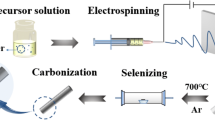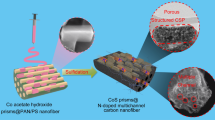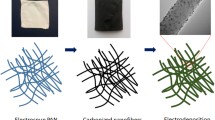Abstract
Cobalt selenide (CoSe2) has become a promising anode material for sodium-ion batteries (SIBs) due to its stable chemical properties, environmental friendliness, and high theoretical capacity. However, the undesirable rate capacity and cycle stability of the anode materials largely limit its applications for SIBs due to the relatively low electronic conductivity and huge volume change during the Na+ insertion/extraction. In this study, electrostatic spinning combined with a wet chemical method is employed to synthesize coral-like composite material (CNF@c-CoSe2/C), which is composed of CoSe2/carbon nanosheet arrays (CoSe2/C) and carbon nanofibers (CNFs). CoSe2/C nanoflakes derived from metal-organic frameworks (MOFs) with high surface area and the porous structure can inhibit the pulverization and amorphization of CoSe2 during charge and discharge processes, thus significantly keeping the stability of the microstructure. CNF can limit the overgrowth of nanosheets and serve as a conductive skeleton. Compared to two-dimensional CoSe2/C nanoflakes and pure CoSe2 nanoparticles, the composite can expose more active sites and effectively accelerate the diffusion of Na+, which displays enhanced rate capability (266.5 mAh·g−1 at 5.0 A·g−1) and cycling stability (268.3 mAh·g−1 after 100 cycles at 1.0 A·g−1). Moreover, the rational preparation strategy for metal selenide-based heterostructure material presents a new way for high-performance SIBs.
Graphical abstract

摘要
硒化钴(CoSe2)因其具有化学性质稳定、环境友好、理论容量大等优点,已成为钠离子电池极具发展前景的负极材料。然而,Na+嵌入/脱出过程中具有相对低的电导率和巨大的体积变化,不理想的速率容量和循环稳定性的负极材料在很大程度上限制了其在钠离子电池中的应用。本研究采用静电纺丝结合湿化学法合成由CoSe2/碳纳米片阵列(CoSe2/C)和碳纳米纤维(CNFs)组成的珊瑚状复合材料(CNF@c-CoSe2/C)。金属有机骨架(MOFs)制备的CoSe2/C纳米片具有高比表面积和多孔结构,可以抑制CoSe2在充放电过程中的粉碎和非晶化,从而显著地保持了微观结构的稳定性。CNF可以限制纳米片的过度生长,并起到导电骨架的作用。与二维CoSe2/C纳米片和纯CoSe2纳米颗粒相比,复合材料能暴露出更多的活性位点,有效加速Na+的扩散,其速率能力增强(5.0 A·g-1时为266.5 mAh·g-1)和循环稳定性增强(1.0 A·g-1时为268.3 mAh·g-1)。此外,硒基异质结构材料的合理制备策略为获得高性能钠离子电池提供了新途径。







Similar content being viewed by others
References
Chayambuka K, Mulder G, Danilov DL, Notten PL. From Li-ion batteries toward Na-ion chemistries: challenges and opportunities. Adv Energy Mater. 2020;10(38):2001310. https://doi.org/10.1002/aenm.202001310.
Su H, Yu HJ. Composite-structure materials for Na-ion batteries. Small Methods. 2018;3(4):1800205. https://doi.org/10.1002/smtd.201800205.
Su H, Jaffer S, Yu HJ. Transition metal oxides for sodium-ion batterie. Energy Storage Mater. 2016;5:116. https://doi.org/10.1016/j.ensm.2016.06.005.
Teng XL, Sun XT, Guan L, Hu H, Wu MB. Self-supported transition metal oxide electrodes for electrochemical energy storage. Tungsten. 2020;2:337. https://doi.org/10.1007/s42864-020-00068-0.
Ding FX, Gao F, Rong XH, Yang K, Lu YX, Hu YS. Mixed-phase Na0.65Li0.13Mg0.13Ti0.74O2 as a high-performance Na-ion battery layered anode. Acta Phys -Chim Sin. 2020;36(5):1904022. https://doi.org/10.3866/PKU.WHXB201904022.
Tabassum H, Zhi CX, Hussain T, Qiu TJ, Aftab W, Zou RQ. Encapsulating trogtalite CoSe2 nanobuds into BCN nanotubes as high storage capacity sodium ion battery anodes. Adv Energy Mater. 2019;9(39):1901778. https://doi.org/10.1002/aenm.201901778.
Zhang LP, Wang W, Lu SF, Xiang Y. Carbon anode materials: a detailed comparison between Na-ion and K-ion batteries. Adv Energy Mater. 2021;11(11):2003640. https://doi.org/10.1002/aenm.202003640.
Huang C, Young NP, Zhang J, Snaith HJ, Grant PS. A two layer electrode structure for improved Li ion diffusion and volumetric capacity in Li ion batteries. Nano Energy. 2017;31:377. https://doi.org/10.1016/j.nanoen.2016.11.043.
Wang B, Miao XW, Dong HL, Ma X, Wu JJ, Cheng YF, Geng HB, Li CC. In situ construction of active interfaces towards improved high-rate performance of CoSe2. J Mater Chem A. 2021;9(25):14582. https://doi.org/10.1039/d1ta03280a.
Song JH, Xiao BW, Lin YH, Xu K, Li XL. Interphases in sodium-ion batteries. Adv Energy Mater. 2018;8(17):1703082. https://doi.org/10.1002/aenm.201703082.
Huang Y, Fang Y, Lu XF, Luan D, Lou XW. Co3O4 hollow nanoparticles embedded in mesoporous walls of carbon nanoboxes for efficient lithium storage. Angew Chem Int Ed. 2020;59(45):19914. https://doi.org/10.1002/anie.202008987.
Liu C, Qiu XY, Liu Y, He XJ, Chen ZQ, Liu MD. Research status and prospects of physical separation technology of spent lithium-ion batteries. Chin J Rare Met. 2021;45(4):493. https://doi.org/10.13373/j.cnki.cjrm.xy19080040.
Li X, Li K, Zhu S, Fan K, Lyu L, Yao H, Li Y, Hu J, Huang H, Mai YW, Goodenough JB. Fiber-in-tube design of Co9S8-carbon/Co9S8 enabling efficient sodium storage. Angew Chem Int Ed. 2019;58(19):6239. https://doi.org/10.1002/anie.201900076.
Wang HQ, Zhao YX, Gou L, Wang LY, Wang M, Li Y, Hu SL. Rational construction of densely packed Si/MXene composite microspheres enables favorable sodium storage. Rare Met. 2022. https://doi.org/10.1007/s12598-021-01895-x.
Bai Q, Yang LF, Chen HL, Mo YF. Computational studies of electrode materials in sodium-ion batteries. Adv Energy Mater. 2018;8(17):1702998. https://doi.org/10.1002/aenm.201702998.
Bin D, Wang F, Tamirat AG, Suo LM, Wang YG, Wang CS, Xia YY. Progress in aqueous rechargeable sodium-ion batteries. Adv Energy Mater. 2018;8(17):1703008. https://doi.org/10.1002/aenm.201703008.
Lu C, Li A, Li G, Yan Y, Zhang M, Yang Q, Zhou W, Guo L. S-decorated porous Ti3C2 MXene combined with in situ forming Cu2Se as effective shuttling interrupter in Na-Se batteries. Adv Mater. 2021;33(33):2008414. https://doi.org/10.1002/adma.202008414.
Fang Y, Yu XY, Lou XW. Formation of hierarchical Cu-doped CoSe2 microboxes via sequential ion exchange for high-performance sodium-ion batteries. Adv Mater. 2018;30(21):1706668. https://doi.org/10.1002/adma.201706668.
Yang XM, Rogach AL. Anodes and sodium-free cathodes in sodium ion batteries. Adv Energy Mater. 2020;10(22):2000288. https://doi.org/10.1002/aenm.202000288.
Gao MR, Yao WT, Yao HB, Yu SH. Synthesis of unique ultrathin lamellar mesostructured CoSe2-amine (protonated) nanobelts in a binary solution. J Am Chem Soc. 2009;131:7486. https://doi.org/10.1021/ja900506x.
Guo YM, Zhang LJ, Dege X, Kang J. Advances of carbon materials as loaders for transition metal oxygen/sulfide anode materials. Chin J Rare Met. 2021;45(10):1241. https://doi.org/10.13373/j.cnki.cjrm.XY20040016.
Kong HB, Cui W, Yan CS, Kong Y, Lv C, Chen G. Interface engineering on cobalt selenide composites enables superior alkali-ion storage. Chem Eng J. 2021;419:129490. https://doi.org/10.1016/j.cej.2021.129490.
Fan SW, Li GD, Cai FP, Yang G. Synthesis of porous Ni-doped CoSe2/C nanospheres towards high-rate and long-term sodium-ion half/full batteries. Chem Eur J. 2020;26(39):8579. https://doi.org/10.1002/chem.202000418.
Zhang ZZ, Du YC, Wang QC, Xu JY, Zhou YN, Bao JC, Shen J, Zhou XS. A yolk-shell structured FePO4 cathode for high-rate and long-cycling sodium-ion batteries. Angew Chem Int Ed. 2020;59(40):17504. https://doi.org/10.1002/anie.202008318.
Yang XM, Wang S, Yu DYW, Rogach AL. Direct conversion of metal-organic frameworks into selenium/selenide/carbon composites with high sodium storage capacity. Nano Energy. 2019;58:392. https://doi.org/10.1016/j.nanoen.2019.01.064.
Park SK, Kim JK, Chan KY. Metal-organic framework-derived CoSe2/(NiCo)Se2 box-in-box hollow nanocubes with enhanced electrochemical properties for sodium-ion storage and hydrogen evolution. J Mater Chem A. 2017;5(35):18823. https://doi.org/10.1039/c7ta05571d.
Qiao F, Liu WJ, Wang SZ, Lin FJ, Chen Y, Yuan M, Weng ZK, Wang SC, Zheng JH, Zhao Y. Hierarchical Co3S4/CoS/MoS2 leaf-like nanoflakes array derived from Co-ZIF-L as an advanced anode for flexible supercapacitor. J Alloys Compd. 2021;870: 159393. https://doi.org/10.1016/j.jallcom.2021.159393.
Ge H, Fan SW, Liu JY, Li GD. In situ growth of CoSe2 coated in porous carbon layers as anode for efficient sodium-ion batteries. Energy Technol. 2021;9(3):2001074. https://doi.org/10.1002/ente.202001074.
Zhang CL, Lu BR, Cao FH, Yu ZL, Cong HP, Yu SH. Hierarchically structured Co3O4@carbon porous fibers derived from electrospun ZIF-67/PAN nanofibers as anode of lithium ion batteries. J Mater Chem A. 2018;27:12962. https://doi.org/10.1039/c8ta03397h.
Niu QJ, Guo JX, Chen BL, Nie J, Guo XD, Ma GP. Bimetal-organic frameworks/polymer core-shell nanofibers derived heteroatom-doped carbon materials as electrocatalysts for oxygen reduction reaction. Carbon. 2017;114:250. https://doi.org/10.1016/j.carbon.2016.12.016.
Shan CS, Feng X, Yang JX, Yang X, Guan HY, Argueta M, Wu XL, Liu DS, Austin DJ, Nie P, Yue YF. Hierarchical porous carbon pellicles: electrospinning synthesis and applications as anodes for sodium-ion batteries with an outstanding performance. Carbon. 2020;157:308. https://doi.org/10.1016/j.carbon.2019.10.015.
Du WY, Shen KQ, Qi YR, Gao W, Tao ML, Du GY, Bao SJ, Chen MY, Chen YM, Xu MW. Efficient catalytic conversion of polysulfides by biomimetic design of “branch-leaf” electrode for high-energy sodium-sulfur batteries. Nano-Micro Lett. 2021;13(1):50. https://doi.org/10.1007/s40820-020-00563-6.
Zhu SQ, Huang AM, Wang Q, Xu Y. MOF-derived porous carbon nanofibers wrapping Sn nanoparticles as flexible anodes for lithium/sodium ion batteries. Nanotechnology. 2021;32(16): 165401. https://doi.org/10.1088/1361-6528/abd8f8.
Cui C, Wei ZX, Zhou G, Wei WF, Ma JM, Chen LB, Li CC. Quasi-reversible conversion reaction of CoSe2/nitrogen-doped carbon nanofibers towards long-lifetime anode materials for sodium-ion batteries. J Mater Chem A. 2018;6(16):7088. https://doi.org/10.1039/c8ta01168k.
Yin H, Qu HQ, Liu ZT, Jiang RZ, Li C, Zhu MQ. Long cycle life and high rate capability of three dimensional CoSe2 grain-attached carbon nanofibers for flexible sodium-ion batteries. Nano Energy. 2019;58:715. https://doi.org/10.1016/j.nanoen.2019.01.062.
Xiao X, Zou LL, Pang H, Xu Q. Synthesis of micro/nanoscaled metal-organic frameworks and their direct electrochemical applications. Chem Soc Rev. 2020;49(1):301. https://doi.org/10.1039/c7cs00614d.
Jiang YL, Zou GQ, Hou HS, Li JY, Liu C, Qiu XQ, Ji XB. Composition engineering boosts voltage windows for advanced sodium-ion batteries. ACS Nano. 2019;13(9):10787. https://doi.org/10.1021/acsnano.9b05614.
Yang J, Gao HC, Men S, Shi Z, Kang XW, Chen SW. CoSe2 nanoparticles encapsulated by N-doped carbon framework intertwined with carbon nanotubes: high performance dual-role anode materials for both Li- and Na-ion batteries. Adv Sci. 2018;5(12):1800763. https://doi.org/10.1002/advs.201800763.
Fang GZ, Zhou J, Cai YS, Liu SN, Tan XP, Pan AQ, Liang SQ. Metal-organic framework-templated two-dimensional hybrid bimetallic metal oxides with enhanced lithium/sodium storage capability. J Mater Chem A. 2017;5(27):13983. https://doi.org/10.1039/c7ta01961k.
Li BQ, Liu Y, Jin X, Jiao SH, Wang GR, Peng B, Zeng SY, Shi L, Li JM, Zhang GQ. Designed formation of hybrid nanobox composed of carbon sheathed CoSe2 anchored on nitrogen-doped carbon skeleton as ultrastable anode for sodium-ion batteries. Small. 2019;15(42):e1902881. https://doi.org/10.1002/smll.201902881.
Zhang L, Dong HL, Wei HX, Ang EH, Yang J, Miao XW, Geng HB, Zuo XB. Interface and structure engineering of bimetallic selenides toward high-performance sodium-ion half/full batteries. J Power Sources. 2021;506: 230216. https://doi.org/10.1016/j.jpowsour.2021.230216.
Tang YC, Zhao ZB, Hao XJ, Wang YW, Liu Y, Hou YN, Yang Q, Wang XZ, Qiu JS. Engineering hollow polyhedrons structured from carbon-coated CoSe2 nanospheres bridged by CNTs with boosted sodium storage performance. J Mater Chem A. 2017;5(26):13591. https://doi.org/10.1039/c7ta02665j.
Weng WS, Xu JY, Lai CL, Xu ZH, Lin J, Zhou XS. Uniform yolk-shell Fe7S8@C nanoboxes as a general host material for the efficient storage of alkali metal ions. J Alloys Compd. 2020;817: 152732. https://doi.org/10.1016/j.jallcom.2019.152732.
Jo MS, Lee JS, Jeong SY, Lim JK, Kang YC, Kang DW, Jeong SM, Cho JS. Golden bristlegrass-like hierarchical graphene nanofibers entangled with N-doped CNTs containing CoSe2 nanocrystals at each node as anodes for high-rate sodium-ion batteries. Small. 2020;16(38):2003391. https://doi.org/10.1002/smll.202003391.
Zhang CH, Pan ZW, Zhu XR, Jiang H, Chen RZ, Xing WH. Pd nanoparticles supported on hierarchically porous carbon nanofibers as efficient catalysts for phenol hydrogenation. Catal Lett. 2021;152(2):340. https://doi.org/10.1007/s10562-021-03640-6.
Liu WJ, Zhao Y, Zheng JH, Jin DY, Wang YQ, Lian JB, Yang SL, Li GC, Bu YF, Qiao F. Heterogeneous cobalt polysulfide leaf-like array/carbon nanofiber composites derived from zeolite imidazole framework for advanced asymmetric supercapacitor. J Colloid Interface Sci. 2022;606(1):728. https://doi.org/10.1016/j.jcis.2021.08.066.
Zhang ZG, Lin J, Hao JY, Xue FF, Gu TF, Zhu ZC, Li QH. Exploration of fast ion diffusion kinetics in graphene nanoscrolls encapsulated CoSe2 as advanced anode for high-rate sodium-ion batteries. Carbon. 2021;181:69. https://doi.org/10.1016/j.carbon.2021.04.095.
Yang SH, Park SK, Kang YC. Mesoporous CoSe2 nanoclusters threaded with nitrogen-doped carbon nanotubes for high-performance sodium-ion battery anodes. Chem Eng J. 2019;370:1008. https://doi.org/10.1016/j.cej.2019.03.263.
Augustyn V, Come J, Lowe MA, Kim JW, Taberna PL, Tolbert SH, Abruña HD, Simon P, Dunn B. High-rate electrochemical energy storage through Li+ intercalation pseudocapacitance. Nat Mater. 2013;12(6):518. https://doi.org/10.1038/nmat3601.
Zhao Y, Wang SC, Yuan M, Huang YP, Lian JB, Yang SL, Li HM, Wu LM. Amorphous MoS nanoparticles grown on cobalt-iron-based needle-like array for high-performance flexible asymmetric supercapacitor. Chem Eng J. 2021;417:127927. https://doi.org/10.1016/j.cej.2020.127927.
Ge P, Hou HS, Cao XY, Li SJ, Zhao GG, Guo TX, Wang C, Ji XB. Multidimensional evolution of carbon structures underpinned by temperature-induced intermediate of chloride for sodium-ion batteries. Adv Sci. 2018;5(6):1800080. https://doi.org/10.1002/advs.201800080.
Acknowledgements
This work was financially supported by the National Natural Science Foundation of China (Nos. 51603092 and 21706103), the Natural Science Foundation of Jiangsu Province (Nos. BK20160537 and BK20170549), and China Postdoctoral Science Foundation (No. 2019T120393).
Author information
Authors and Affiliations
Corresponding authors
Ethics declarations
Conflicts of interests
The authors declare that they have no conflict of interests.
Supplementary Information
Below is the link to the electronic supplementary material.
Rights and permissions
Springer Nature or its licensor (e.g. a society or other partner) holds exclusive rights to this article under a publishing agreement with the author(s) or other rightsholder(s); author self-archiving of the accepted manuscript version of this article is solely governed by the terms of such publishing agreement and applicable law.
About this article
Cite this article
Hu, JZ., Liu, WJ., Zheng, JH. et al. Coral-like cobalt selenide/carbon nanosheet arrays attached on carbon nanofibers for high-rate sodium-ion storage. Rare Met. 42, 916–928 (2023). https://doi.org/10.1007/s12598-022-02146-3
Received:
Revised:
Accepted:
Published:
Issue Date:
DOI: https://doi.org/10.1007/s12598-022-02146-3




